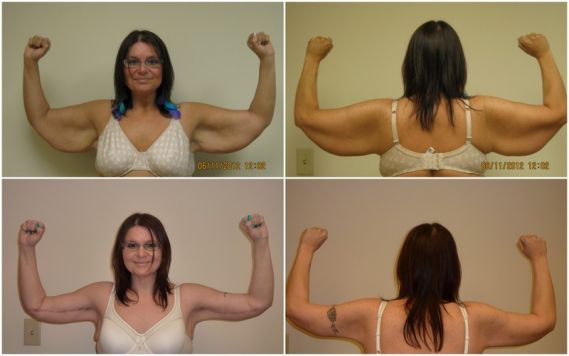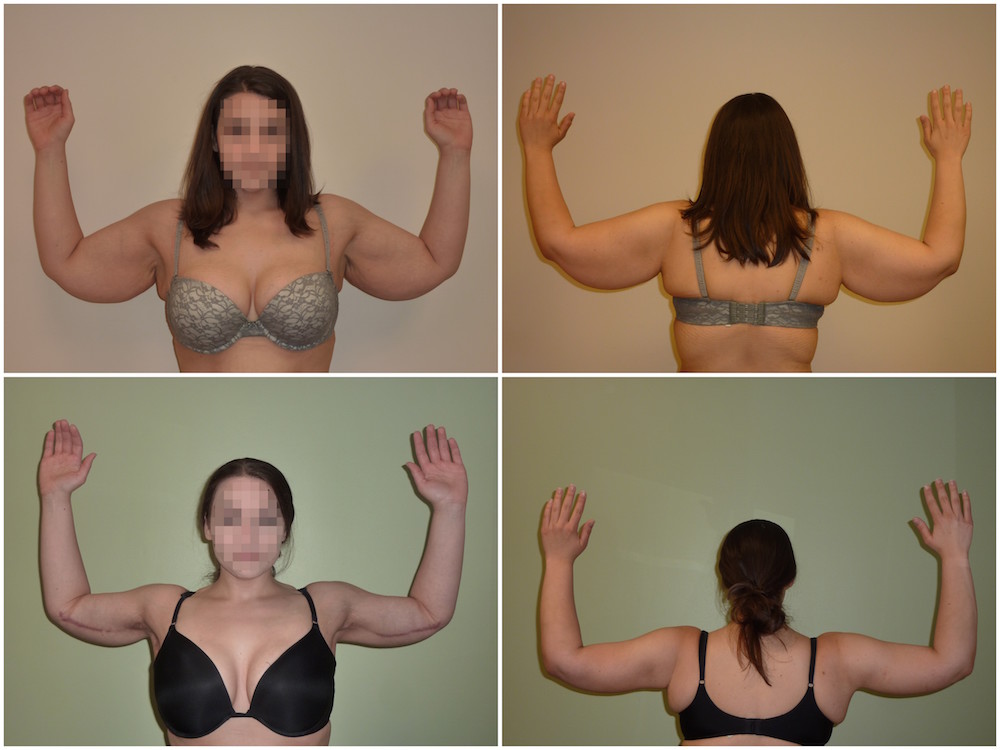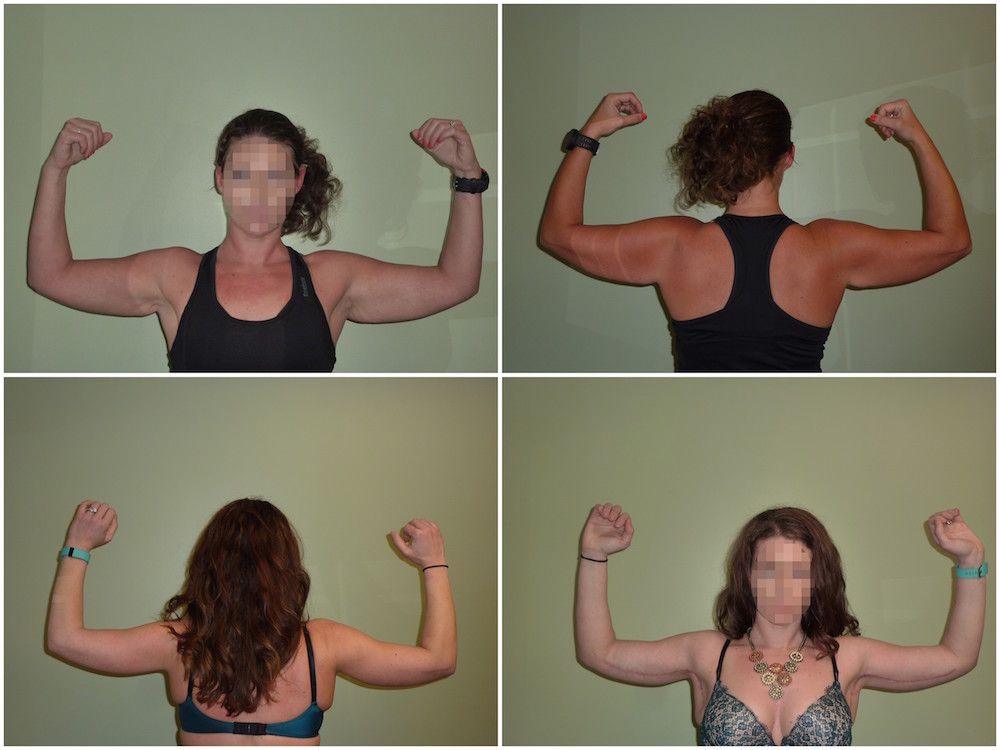Leading Brachioplasty Procedures
The number of patients seeking body contouring procedures has grown exponentially over the last decade as we have come to understand the effectiveness of bariatric surgery. One of the areas most commonly affected by massive weight loss is the upper arms, although genetics and aging can also result in the same problem. Patients often say “it runs in my family” and that their mother and grandmother have the same problem. The skin on the inner part of the upper arm is extremely thin and as a result has a lower elastin component than other areas. This translates into an inability of skin to “shrink” back to size after massive weight loss. Despite achieving a relatively normal body weight and working out extensively on the arms at the gym, many women find that their upper arm and armpit skin remains loose and hangs down significantly. Some even refer to the area as their “bat wings”. It can be particularly bothersome because the arms are exposed more than almost any other body part.
Brachioplasty, or arm lift surgery, entails removing excess skin and fat on the upper arm. I usually combine the skin excision with liposuction if there is any excess fat, particularly on the front, back or outer arm. Adding liposuction allows for additional skin removal resulting in the maximum amount of circumferential reduction. For patients with good skin tone and minimal drooping skin, liposuction alone can give an excellent result. Many patients have skin laxity in the armpit area, also known as the axilla. The technique that I use addresses this area as well so that there is little or no skin “hanging over the top of the bra” under your arms. The scar is well-hidden on the inside of the arm so it cannot be seen from the front or back. I prefer this approach over what’s known as the “posterior” brachioplasty which results in a scar that you can’t see but everyone behind you is able to see.
After surgery you can expect smoother skin and a shape and size more proportionate to your lower arm and torso. Most importantly, you will be able to feel comfortable in short sleeve shirts and look forward to wearing summer clothes again.
FAQ
The technique which I have used for a number of years is called the L-brachioplasty. It has provided excellent results with very few complications, and consistently satisfied patients. The scar runs on the inner part of the arm from just above the elbow crease to the armpit and then down the chest wall for a short distance. Most of the armpit hair-bearing skin is removed which means that most women no longer need to shave in that area after surgery. Unless your arms are raised the scar is not visible from the front or back. We instruct you as to how to care for your scar to further diminish the appearance once it has matured. The interventions that we always recommend are moisturizer, massage, sun block and silicone or paper tape. All of these contribute to more rapid flattening and fading of the scar.
There is minimal pain post-operatively because only skin and fat are involved. All of the sutures are dissolving and the tape over the incisions falls off after about one week. Mildly compressive ACE wraps are worn the first night followed by a compressive garment that is worn for several weeks afterward. A drain will be placed in each arm in most cases that is removed the morning after surgery. Most women are able to control the mild discomfort with Tylenol or Advil but you are given a prescription for pain killers in the event that you require more relief.
Your results will be long-lasting and any loosening of the skin is usually easily addressed in the office in a minor procedure. Slight fluctuations in weight does not have a great effect on the upper arms, particularly if liposuction was performed as part of the procedure.
Since so many patients have undergone bariatric surgery in the last decade I have become very experienced in body contouring after massive weight loss. I routinely speak at the Dartmouth-Hitchcock Clinic bariatric support group meetings so that patients have a good understanding of the options that are available to them as they continue on their journey of self-improvement following their weight-loss surgery.
I prefer that my patients stay active and in fact require that you are up and walking around the evening of surgery. Light exercise can begin after several days, not including chest/arm-specific weight training. All restrictions are removed after six weeks, and sometimes even earlier depending on your personal progress. It is important to follow all instructions during the early postoperative period to ensure excellent results. I always remind my patients that they went through the effort to have the surgery and to give themselves the proper time to recover.
You arrive at the facility approximately an hour prior to your scheduled time of surgery. The skilled nursing staff greets you and takes you to a private room in the preoperative area where you change and complete the admission process. You then meet your anesthesiologist who reviews your history with you and explains the procedure of going to sleep and waking up in the most comfortable and safe way possible. I arrive shortly thereafter to mark you for your surgery and answer any last minute questions that you might have. You receive a single dose of intravenous antibiotics as prophylaxis against infection and are then taken into the operating room where you comfortably drift off to sleep and wake up two hours later with your newly contoured breasts. After a short time in the recovery room you are taken back to the private room where you began before surgery. Your nurse then reviews the postoperative instructions that we provided you with and gets you ready for discharge usually within two hours of leaving the operating room. You can expect a call from me that evening to make sure that you are doing well. Remember, my phone number is provided to you and is on 24/7 for my patients.
You are seen in the office the day after your surgery so that Sarah can answer any questions you may have about the early postoperative period. Your drains will be removed and you can shower as soon as you get home. You will also begin wearing a more convenient and comfortable compression garment from this point on. I see you multiple times out to at least one year following your surgery, and anytime after that if you desire. My goal is to provide excellent and long-lasting results in a practice that is always there for you.
Contact our office today to schedule your initial consultation with Dr. Reilly.
Learn more about arm lifts from the American Society of Plastic Surgeons.



